Moniek Bloks's Blog, page 188
February 27, 2020
Mary Stuart O’Donnell – An Irish Lady in exile (Part two)
In part one of Mary Stuart O’Donnell’s story, we learned of how she was born after most of her family fled Ireland for the continent in The Flight of the Earls 1607. Mary was raised by her mother in Donegal and then by her grandmother Lady Kildare in London. Mary was due to inherit her wealthy and highly esteemed grandmother’s fortune, but due to her Catholic faith, she refused to marry a Protestant man. Mary then fled the country in men’s clothing with the aim of returning to Ireland.
We pick up Mary’s tale in Bristol, where she was breaking her journey with her maid Anne, both dressed as men to disguise Mary’s identity from authorities. According to records, Mary, Anne and possibly Mary’s lover Dudley O’Gallagher tried to get to Ireland twice but failed and instead took a ship to Cadiz before moving on to France and finally Brussels.
It is rare to have accounts of day to day life of women in the seventeenth century, especially accounts of escape and daring adventure. Unusually, we do have a number of accounts about Mary and her journey to the court in Brussels so we can read about what she got up to on her travels. Mary’s trip to Brussels took six weeks, and details of this are found in a short biography written in by a man named Alberto Enriquez. It seems the book was written to make Mary look like a heroic and godly woman to the sovereign Archduchess Isabella Clara Eugenia who Mary would be appealing to for financial support.
In the short book, it is clear that Mary was controlling the writing of the book, and it also appears that the text was written to stop gossip and scandal erupting around the O’Donnells on the continent. At this time, her brother Hugh O’Donnell, 2nd Earl of Tyrconnell was battling with Seán Ó Néill, Earl of Tyrone over who would lead a Spanish backed army into Ireland; the Archduchess would be instrumental in making this choice. A sister turning up on the continent could be advantageous or disastrous to Hugh, depending of course on how she conducted herself.
In Enriquez’ account, he tries his best to make Mary sound like a devoted Catholic woman who threw away her fortune for her faith and headed to the continent for safety. It must be said that he does not mention her travelling with a lover… while other accounts state that she was on the run with a man of low rank which explains the scandal around her.
In the start of his account, which is addressed to the Archduchess, Enriquez states that during her six-week journey, Mary had no choice but to dress as a man and act as such. When others questioned why she maintained the disguise once out of England, Enriquez says; “she could not avoid the various incidents that arose on her journey, nor escape from the various duels, nor avoid some amorous encounters”. Here Enriquez is saying Mary was forced to get drunk, get into fights, seduce and sleep with women in order to hide her true identity, which all seems pretty far-fetched! Nevertheless, Enriquez tried his best to rid Mary of scandal and paint her out as a saint.
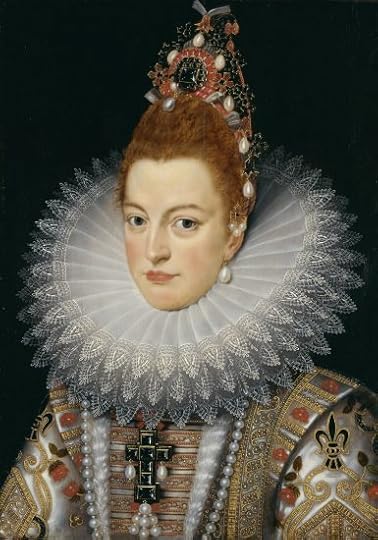 Isabella Clara Eugenia (public domain)
Isabella Clara Eugenia (public domain)Sometimes the account struggles to explain why Mary did certain things on her journey, and it is quite funny to read. The book describes how bad weather forced them to abandon their trip to Ireland and instead spend weeks drinking in pubs before trying to reach mainland Europe. Though trying to reach Antwerp, the weather meant they ended up travelling to Cadiz! In Cadiz, we hear how Mary and her group fought with pirates before heading on to La Rochelle, Poitiers and Paris. Around France, Mary not only ended up in fights but she also started duels with a number of men in order to make herself seem like a man. It is here that she also seduced more women and supposedly made love to one of them in public. As we can see, none of these actions seemed necessary, and Alberto Enriquez struggled to explain these actions away!
When Mary eventually met the Archduchess in January 1627, the Archduchess was happy to meet her, and the court was overjoyed to have such a high-ranking Irish Lady in their midst. Mary even received a letter of congratulation for her daring escape from Pope Urban VIII. It seemed to everyone that if Mary could be married off to the Earl of Tyrone, then the quarrels between the two Irish Earls could be over and there was great enthusiasm for this plan.
Of course, as we know by now, Mary did not like to do as she was told and refused to go ahead with the marriage. In a letter to the secretary of King Phillip IV of Spain, the Archduchess said: “the sister of Tyrconnell has declared that she has no wish whatever to marry Tyrone”. Soon after, the invasion of Ireland was cancelled which must have been at least partly due to failure to link the O’Neill’s and O’Donnell’s in marriage. Mary’s brother Hugh could not conceal his anger with his sister for her refusal to marry Sean and the fact she was still galivanting around in men’s clothing when she wished to and blackening the family name.
Hugh even went as far as distributing a letter which claimed Mary to be a fraud, he said “Having heard that some woman in man’s clothes is travelling through your parts by the name of my sister, defaming me and my house” and later he wished to “procure the arrest of that woman, not alone in consideration of my honour, but that of our nation”. It was clear that her refusal to marry O’Neill and her behaviour on her journey had resulted in Mary being disowned by her brother entirely.
By this time it was clear that Mary was in fact in a relationship with Dudley O’Gallagher and despite receiving support from the Archduchess Isabella Clara Eugenia and her court, Mary had outstayed her welcome in Flanders. After this, Mary and Dudley moved on to Italy, and we can follow her movements as she wrote to the King’s court in Spain and to the papacy for financial support. At first, she was granted 2,400 florins yearly from the Spanish court, but by 1632 Mary herself wrote about a dire financial situation in a letter to the Pope’s nephew.
In this letter dated 9th February 1632, Mary explained how she had married O’Gallagher and given birth to a son in Genoa. Mary stated that if it was not for the kindness of two cardinals, she “should perish with the others of hunger, cold and infinite other sufferings”. The primary role of Cardinal Ludovisi was to maintain the Irish college, and he did not have the means to keep Mary in conditions which befitted her rank. Mary described her housing in Rome as “two miserable little rooms” and said she was “reduced…to this utter wretchedness”. Mary’s letter was written in order to evoke sympathy from the papacy, and she emphasised her royal blood and high education in the letter.
Despite Mary’s pleas, it seems that the papacy was unwilling to fund her and her husband any longer after this time and she struggled on a meagre allowance from the Archduchess and her husband’s pay as a soldier. The couple eventually moved on to Austria and had another son. In Austria, Dudley climbed the ranks to become a Captain in the Imperial Army but died in service in 1635. Sadly it seems that both of the couple’s children died in infancy.
Little is known of Mary’s life after the death of her husband. It is said that Mary travelled again around Europe before returning to Rome and marrying an Irish Naval Captain who was also poor in 1639. This is a sad close to the tale of such a brave, adventurous lady who threw away an easy life in England for her faith and family. If Mary had not been disowned by her brother Hugh, her life would likely have followed a happier path.1
The post Mary Stuart O’Donnell – An Irish Lady in exile (Part two) appeared first on History of Royal Women.
February 26, 2020
Mary Stuart O’Donnell – An Irish Lady in exile (Part one)
On 14 September 1607, a French ship left Lough Swilly in County Donegal, Ireland and headed for Spain. On this vessel were 99 people, most of whom would never see Ireland again. On the ship were Hugh O’Neill, 2nd Earl of Tyrone, Cú Chonnacht Óg Mag Uidhir of Fermanagh, and Rory O’Donnell, Earl of Tyrconnell along with family members, servants and soldiers. These men were among the last native Irish rulers in the North, but they had seen their power diminish and their lands carved up by the Tudor plantations of Ulster.
Why this event, remembered as The Flight of the Earls took place has long been debated as the Earls left Ireland suddenly and with no real explanation. It seems the men were in constant fear of arrest by the English government after being implicated in fictional treasonous plots and were becoming increasingly disheartened at their own much-reduced powers due to land redistribution by the English crown. Seeing no other option, the Earls and their followers left for Spain aiming to return with troops and regain their full territories, however, the Earls died in exile not long after leaving, and this did not come to pass. The Flight of the Earls was the end of the old Gaelic order in Ulster.
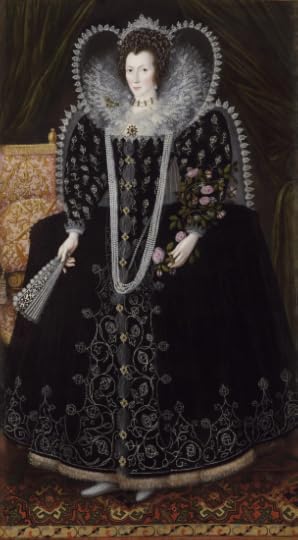 Portrait of a Lady, probably Frances Howard, dowager Countess of Kildare (public domain)
Portrait of a Lady, probably Frances Howard, dowager Countess of Kildare (public domain)As mentioned above, many family members left with the Earls, but one key member of the O’Donnell family was missing from the boat, her name was Bridget Fitzgerald. Bridget was the wife of Rory O’Donnell; once known as the King of Tyrconnell and head of the O’Donnell clan, Rory had lost land and power under King James I and was granted the lesser title of Earl. Bridget was also from an esteemed family line: her mother, Lady Frances Howard had been Lady of the Privy Chamber for Queen Elizabeth I and was in favour with King James I, while her grandfather was Charles Howard, Lord High Admiral and was related to Elizabeth I through his cousin Anne Boleyn.
When Rory O’Donnell fled from Rathmullan, he took with him his infant son Hugh but left behind his young wife because she was heavily pregnant. It seems that Bridget tried to follow her husband but was intercepted by the English authorities and ended up giving birth to a daughter named Mary in England. Bridget’s mother, Lady Kildare, advised her daughter to go to King James I for help and to deny any knowledge of her husband’s flight.
Bridget took her mother’s advice and thankfully King James was sympathetic and granted a yearly allowance to Bridget and Mary from Rory O’Donnell’s lands. King James found a fondness for the baby Mary and due to both Bridget’s links to the Howard family and King James sharing an ancestor King Robert II of Scotland with baby Mary, he proclaimed himself the child’s protector and even gave Mary the royal surname ‘Stuart’. When Mary was around two years old, her mother was permitted to return to the Kildare lands with her and raise her in the Catholic faith. Mary’s father Rory died on the continent, and her infant brother inherited his title in exile. Mary, the daughter of an Irish Earl, raised a Catholic and yet protected by King James I must have grown up with a rather confused identity.
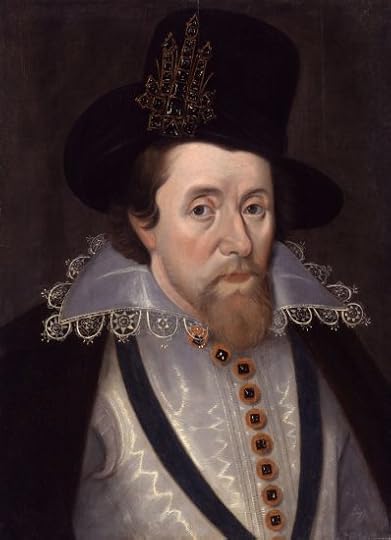 King James I (public domain)
King James I (public domain)By 1619, Mary’s mother had been remarried to an Englishman Nicholas Barnewall for two years and would give birth to nine children in the coming years with her new husband. At this time the twelve-year-old Mary was called over to England to live in the household of her grandmother Lady Kildare. Lady Kildare planned to educate her granddaughter and marry her to a protestant nobleman with the aim of making the girl the heir to her vast fortune. Mary would have had her grandmother’s wealth and influence on her side and a dowry from King James I to provide her with a fine marriage match when the time came. If Mary had followed her grandmother’s wishes, she would have lived a life of plenty and resided with a husband and probable children in a great house. However, tempting this comfortable life may have been, Mary decided to go against her grandmother’s wishes and escape the English court.
In 1626, Mary, who had become quite a handful, was involved in a plot to free Irish relatives who were imprisoned in Gatehouse prison. When summoned to speak before the royal council about this, the nineteen-year-old decided instead to turn her back on her Howard relatives and her grandmother. With King James I now being dead and King Charles I on the throne, Mary found herself less welcome at English court. After refusing to marry a Protestant nobleman because of her devotion to Catholicism, she believed her only option was to find her brother Hugh and seek the protection of Catholic royals and the papacy.
It is after Mary’s own flight that we see her daring, adventurous character unravel away from the guardianship of her grandmother. Mary, a maid Anne Baynham and possibly Mary’s lover Dudley escaped London, with the women dressed in men’s clothing. In order to prove herself to be a man, Mary started to go by the name of Ralph on her journey, and when she reached Bristol, she fought in a duel and even made love to another woman.
In the second part of Mary’s story, we will follow her journey to the royal court in Brussels, uncover details from a biography written on her and see what happened to this fascinating lady later in life.1 (Coming soon)
The post Mary Stuart O’Donnell – An Irish Lady in exile (Part one) appeared first on History of Royal Women.
February 25, 2020
Lydia Liliuokalani Kawānanakoa – Regal grace and dignity
Helen Lydia Kamakaʻeha Liliʻuokalani Kawānanakoa was born on 22 July 1905 as the daughter of Prince David Kawānanakoa and Princess Abigail Campbell Kawānanakoa. As she was born after the monarchy in Hawaii was abolished, she did not officially carry a royal title though many referred to her as such. She was named for Queen Liliʻuokalani, who was the last Queen of Hawaii. Her father David and his younger brother Kuhio were named princes of the realm and heirs presumptive to the throne behind Princess Kaiulani.
Liliuokalani would be one of three siblings. She had an elder sister named Abigail and an elder brother named David. Lydia received her education at a convent school in San Francisco. In 1922 a Toledo newspaper reported, “A princess with bobbed hair! The long golden curls of the storybook have suddenly changed to black shorn locks and worse still, this little lady who could wear the cloak of royalty, much prefers being a flapper. Princess Liliuokalani Kawanawakoa of Hawaii has come to America to continue her education in a San Francisco convent. Lazy and happy, she says she is, and she likes to ride, swim, and dance, but we will not say much about what she thinks of study, although she is a game little princess.”1
On 17 January 1925, Liliuokalani married her first husband William J. Ellerbrock, who was an automobile salesman. From this marriage, she had one daughter named Abigail. The marriage ended in divorce in 1927. Her daughter was adopted by her mother. Her second husband was Charles James Brenham whom she married on 11 August 1928. This marriage too ended in divorce. In 1936, she met newspaperman Clark G. Lee, and she followed him to Tokyo when he was transferred there in 1938. They were married in Hong Kong that same year. They lived together in Tokyo and Shanghai until she returned to Hawaii in August 1941. They moved to Pebble Beach in California in 1946. Her husband died of a heart attack in 1953 and Lydia once again returned to Hawaii. In 1954, she married Charles E. Morris Jr, but their marriage too ended in divorce in 1959. They remarried in 1968.
Liliuokalani remained devoted to Hawaii her entire life. She was active in the Hawaiian Civic Clubs and served on the Hawaiian Homes Commission. She was also a member of the Kaahumanu Society and the Daughters of Hawaii. In 1965, she was named head of the Iolani Palace restoration project.
In 1967, she was diagnosed with cancer. She tried to continue her activities for the Iolani Palace project but also spent much time in the hospital. She died on 19 May 1969 at the age of 63. At her request, the funeral was conducted without pomp and ceremony.
She was later described by Governor John A. Burns with the words, “A vital and colourful chapter in Hawaii’s history comes to a close with the passing of Liliuokalani Kawananakoa Morris. All Hawaii mourns her death. As the last of her generation of the Kalakaua dynasty, Mrs Morris was one of the leading alii2 of our islands. Her regal grace and dignity impressed all who were privileged to know her. She continually strove to set the highest example for her people so that they would be inspired to the greatness that is their heritage. Her contributions to the welfare of the Hawaiians and the island she loved so dearly have been substantial indeed.”3
The post Lydia Liliuokalani Kawānanakoa – Regal grace and dignity appeared first on History of Royal Women.
February 24, 2020
Q&A with Hugo Vickers, author of The Crown Dissected: An Analysis of the Netflix Series The Crown Seasons 1, 2 and 3
1. What do you think Queen Elizabeth II’s greatest legacy will be?
The Queen has already had a remarkable reign of 68 years, in which she has given Britain and the Commonwealth a sense of calm continuity and stability. She has been a great conciliator. She came to the throne just after the war years, and helped smooth diplomatic relations with many countries – Germany, Japan, Ireland – she went to Russia and China. We have had a most wonderful head of state. So she has shown the world what a dignified monarch can achieve.
2. What impact did the Queen Mother and Queen Mary have on The Queen’s reign and her relationship with her family and her people?
Queen Mary died in 1953 and the Queen only came to the throne in 1952, but her influence was to show the Queen how to be a dutiful monarch. The Queen Mother was only 51 at the beginning of the reign and lived 50 years into it, so she was a working Queen Mother, with a diplomatic, ambassadorial and social role. As you know she was much loved. She was more flamboyant than the Queen so attracted great affection. While alive she was very much the matriarch of the family, and the Queen deferred to her on many things. Prince Charles, in particular, adored her.
3. What’s the most important thing for people to know about The Crown?
It is well made, well written and lavishly produced, but it is dishonest because it twists the facts, very often to the disadvantage of those living people portrayed in it. So it must be viewed with great suspicion.
4. Why was it important for you to write your analysis of The Crown?
I needed to set the record straight, so I watched every episode twice, and have taken each one apart forensically, pointing out the errors, some of which are very great – and some minor (details etc). Even people who enjoy The Crown (which I don’t) can find my account useful.
Be on the lookout for our review of “The Crown Dissected: An Analysis of the Netflix Series The Crown Seasons 1, 2 and 3” in the coming weeks!
The Crown Dissected: An Analysis of the Netflix Series The Crown Seasons 1, 2 and 3 is available now in the UK and the US.
The post Q&A with Hugo Vickers, author of The Crown Dissected: An Analysis of the Netflix Series The Crown Seasons 1, 2 and 3 appeared first on History of Royal Women.
February 23, 2020
Helen of Serbia – A determined Princess
Helen of Serbia was born on 4 November 1884 (O.S. 23 October) in Cetinje, Montenegro as the daughter of King Peter I of Yugoslavia and his wife Princess Zorka of Montenegro. Her mother would tragically die in childbirth six years later, and her father did not remarry. She spent most of her childhood under the care of her mother’s sisters Anastasia and Milica.
Her aunt Milica married Grand Duke Peter Nicolaievich of Russia in 1889, while her aunt Ansastia would marry Grand Duke Nicholas Nicolaevich of Russia in 1907 after her divorce from George, Duke of Leuchtenberg. Helen received her education at the Smolny Institute in Russia. Helen was often at the Russian court, with another aunt Princess Vera of Montenegro who was actually younger than Helen.
Margaretta Eagar, who was a governess to the daughters of Tsar Nicholas II wrote of Helen, “That year in the Crimea we saw a great deal of Princess Ellen, now of Servia. She was a very sweet-faced though plain girl, with beautiful dark eyes, very quiet and amiable in manner. The little Grand Duchess Olga was very fond of her, and Princess Ellen would often come to tea in the nurseries, her young aunt, Princess Vera
of Montenegro, and the young cousins with whom she lived most of the time. Princess Ellen was about seventeen years of age. Her mother had been dead for many years, and she lived chiefly with one or other of the aunts in Russia. What a change has come into her life! I often think of her with deep pity and compassion. She can never know an easy moment, surrounded as she is by the assassins of the late king and queen. Poor, gentle, amiable girl! What will be her fate?”1
Helen was introduced to Prince John Constantinovich of Russia by yet another aunt, Elena of Montenegro, Queen of Italy. It was an apparent love match, and he proposed not much later. It came as a surprise to most of the family as John had considered becoming a Russian Orthodox monk. The Tsar’s daughter Tatiana wrote to her aunt Grand Duchess Olga, “Perhaps you know that Ioanchik is engaged to Helene of Serbia, it is so touching. How funny if they might have children, can they be kissing him? What foul, fie!”2
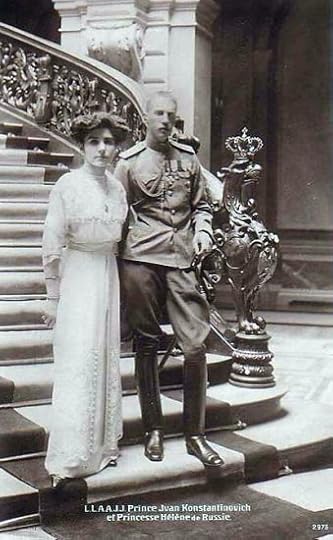 (public domain)
(public domain)They were married on 3 September 1911 (O.S. 21 August) at the Peterhof3, and Helen took the name Princess Yelena Petrovna of Russia. Helen wore a silver brocade gown and the veil of the Karageorgevitch family. She wore the red ribbon with the silver border of the Order of St. Catherine.4
Helen took up medical classes at the University of St. Petersburg after she married John, but she gave it up when their first child was born. Their first child was a son named Vsevolod Ivanovich, and he was born on 20 January 1914. A daughter named Catherine Ivanovna was born on 12 July 1915.
Prince John fought at the front during the First World War, and he was there when the Russian Revolution broke out in 1917. In the spring of 1918, John was exiled to the Urals by the Bolsheviks, and Helen left her children with her mother-in-law Grand Duchess Elizabeth Mavrikievna of Russia (born Princess Elisabeth of Saxe-Altenburg) at the Palace of Pavlovsk near Petrograd and followed her husband into exile. Helen ended up in Yekaterinburg with her husband and Grand Duchess Elizabeth Feodorovna, the Tsarina’s sister, and several other. However, Helen had not been arrested, and she lived in rooms rented from a Cossack couple. In May, those who had been arrested were told they were to be moved to the mining town of Alapayevsk. Helen discussed the situation John and asked for permission to return to Yekaterinburg, where she would further request permission to go to Petrograd. However, once in Yekaterinburg, she did not receive permission to travel further and once again rented the same rooms.
Helen began to make almost daily visits to the British consulate, demanding that the consul would intervene on her husband’s behalf. She also demanded to be allowed to return to Petrograd, and she wanted to enter the Ipatiev House where the Tsar and his family were being held. She was eventually warned that if she did not stop, she would be arrested and put in prison. Nevertheless, Helen showed up at the gates of the Ipatiev House and loudly announced, “I am the wife of a Romanov interned at Alapayevsk, and I am also the daughter of the King of Serbia. As a relative of the Emperor, I have come to get news of him and ask to be allowed to see him.” The commandant eventually came out to speak to her, and while he did not allow her to come inside, he promised to tell the Tsar that she had come.5 The authorities eventually tired of Helen and she was arrested and put in prison for two weeks. After those two weeks, she put on a train back to Petrograd.6
In July 1918, Prince John was murdered in a mineshaft near Alapayevsk alongside Grand Duchess Elizabeth Feodorovna and other members of the family. He was still only 32 years old. Helen’s mother-in-law and Helen’s two children were allowed to leave Russia in October 1918 after Swedish diplomats intervened. Helen was also eventually allowed to leave and joined her children in Sweden. They moved around quite a bit, first moving to Paris, then Belgrade, Cap Ferrat before settling in England where Vsevolod was educated at Eton and Oxford. She hardly ever spoke Russian with her children as hearing the language pained her.
Helen eventually moved to France where she died on 16 October 1962 at the age of 77 after being rushed to the hospital the night before with a lung ailment.7
The post Helen of Serbia – A determined Princess appeared first on History of Royal Women.
February 22, 2020
Female Heirs – Princess Estelle, Duchess of Östergötland
With the introduction of absolute primogeniture in most European monarchies, there are now several Queens in waiting. With our new series Female Heirs, we’ll be taking a look at those young women who will one day rule in their own right. Today we’ll be taking a look at Princess Estelle, Duchess of Östergötland.
Embed from Getty Images
On 23 February 2012, Crown Princess Victoria of Sweden gave birth to her first child – a daughter named Princess Estelle Silvia Ewa Mary, Duchess of Östergötland. Her father is Prince Daniel, born Daniel Westling. Due to absolute primogeniture, Princess Estelle will one day succeed her mother as Queen Regnant. She was born at the Karolinska University Hospital in Solna. A 21-gun salute was held opposite the Royal Palace. The following day her names were announced by her grandfather King Carl XVI Gustaf, followed by a Te Deum service.
Embed from Getty Images
Estelle’s baptism took place on 22 May 2012 in the Royal Chapel of Stockholm Palace. Her godparents were Prince Carl Philip of Sweden, Anna Westling-Söderström, King Willem-Alexander of the Netherlands, Crown Princess Mary of Denmark and Crown Prince Haakon of Norway. She was baptised in an antique christening gown, and her name and date of baptism were embroidered into the gown.
Embed from Getty Images
Princess Estelle has been slowly introduced to royal life. From a young age, she undertook childproof royal duties – such as the opening of fairytale path named for her when she was two years old. She began her education on 25 August 2014 at the Äventyret Preschool. She is currently attending the Campus Manila School. A younger brother named Oscar was born in 2016.
Embed from Getty Images
If she becomes Queen as expected, she will be Sweden’s fifth Queen Regnant, following Margaret, Christina and Ulrika Eleonora and her mother, Victoria.
The post Female Heirs – Princess Estelle, Duchess of Östergötland appeared first on History of Royal Women.
February 21, 2020
Book News March 2020
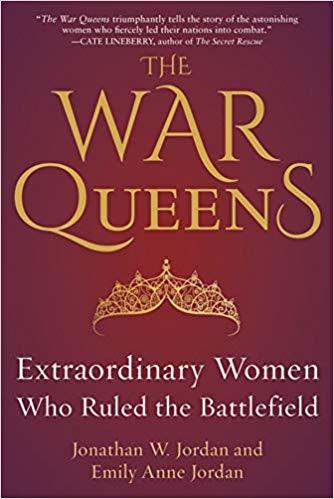
The War Queens: Extraordinary Women Who Ruled the Battlefield
Hardcover – 10 March 2020 (US) & 26 March 2020 (UK)
History’s killer queens come in all colors, ages, and leadership styles. Elizabeth Tudor and Golda Meir played the roles of high-stakes gamblers who studied maps with an unblinking, calculating eye. Angola’s Queen Njinga was willing to shed (and occasionally drink) blood to establish a stable kingdom in an Africa ravaged by the slave trade. Caterina Sforza defended her Italian holdings with cannon and scimitar, and Indira Gandhi launched a war to solve a refugee crisis.
From ancient Persia to modern-day Britain, the daunting thresholds these exceptional women had to cross―and the clever, sometimes violent ways in which they smashed obstacles in their paths―are evoked in vivid detail. The narrative sidles up to these war queens in the most dire, tumultuous moments of their reigns and examines the brilliant methods and maneuvers they each used to defend themselves and their people from enemy forces.
Father-daughter duo Jonathan W. and Emily Anne Jordan extoll the extraordinary power and potential of women in history who walked through war’s kiln and emerged from the other side―some burnished to greatness, others burned to cinders. All of them, legends.
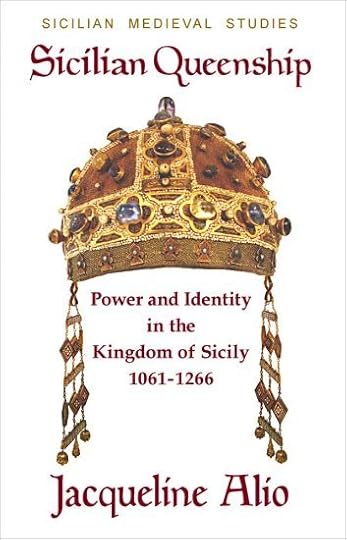
Sicilian Queenship: Power and Identity in the Kingdom of Sicily 1061-1266
Paperback – 1 March 2020 (US & UK)
This supplement to the author’s groundbreaking compendium, Queens of Sicily 1061-1266, brings us further insight into the lives and times of the earliest countesses and queens of Sicily, introducing a few topics and details considered here for the first time. Chapters are dedicated to such subjects as: the queens’ use of power in suppressing adversaries, reginal patronage, reginal titles and heraldry, words spoken by the queens, court cuisine, court poetry, places identified with the queens, the queens as part of Sicilian cultural identity, and more. A chapter also lists current work in the field by various historians. This book begins a new conversation in Sicilian women’s studies.
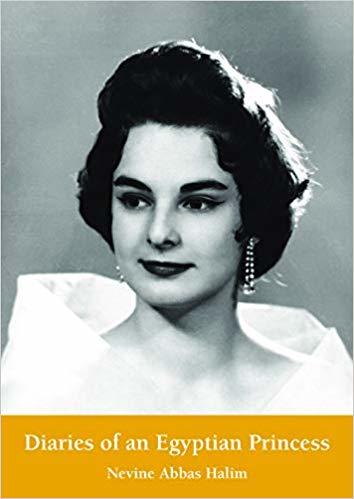
Diaries of an Egyptian Princess
Hardcover – 3 March 2020 (US) & 1 February 2020 (UK)
Princess Nevine Halim is a direct descendant of the dynasty that ruled Egypt from 1805 until the abdication of King Farouk in the wake of the Free Officers coup in 1952. The eldest of three children, she was born in Alexandria on 30 June 1930, the great-great-granddaughter of Muhammad Ali Pasha on her father’s side and the great-granddaughter of Khedive Ismail on her mother’s side. Drawing on her own diary, as well as those of her mother and grandmother, she takes us on a journey from the First to the Second World War, from Egypt to Europe and the United States, from a world of glamor, wealth, and privilege to the fugitive existence of the exile and social outcast after 1952. We also meet her father, Abbas Halim, the charming rebel prince who clashed with King Fuad for championing the rights of workers, as well as many other members of the Egyptian royal family and a glittering host of international royals, politicians, and film stars. Packed with royal gossip and political intrigue, with tales of young love and fashionable society, and of princes and princesses dancing perilously close to the edge of a way of life that would one day fall apart and then vanish, Diaries of an Egyptian Princess is an event-filled account of an endlessly fascinating epoch in modern Egyptian history.
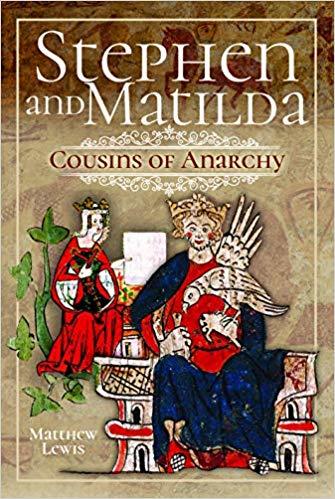
Stephen and Matilda’s Civil War: Cousins of Anarchy
Hardcover – 30 October 2019 (UK) & 4 March 2020 (US)
The Anarchy was the first civil war in post-Conquest England, enduring throughout the reign of King Stephen between 1135 and 1154. It ultimately brought about the end of the Norman dynasty and the birth of the mighty Plantagenet kings. When Henry I died having lost his only legitimate son in a shipwreck, he had caused all of his barons to swear to recognize his daughter Matilda, widow of the Holy Roman Emperor, as his heir and remarried her to Geoffrey, Count of Anjou. When she was slow to move to England on her father’s death, Henry’s favourite nephew Stephen of Blois rushed to have himself crowned, much as Henry himself had done on the death of his brother William Rufus.
Supported by his brother Henry, Bishop of Winchester, Stephen made a promising start, but Matilda would not give up her birthright and tried to hold the English barons to their oaths. The result was more than a decade of civil war that saw England split apart. Empress Matilda is often remembered as aloof and high-handed, Stephen as ineffective and indecisive. By following both sides of the dispute and seeking to understand their actions and motivations, Matthew Lewis aims to reach a more rounded understanding of this crucial period of English history and asks to what extent there really was anarchy.
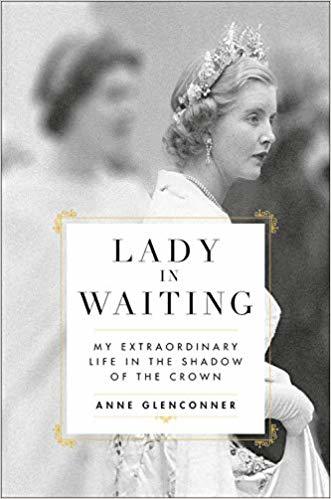
Lady in Waiting: My Extraordinary Life in the Shadow of the Crown
Hardcover – 24 March 2020 (US)
Anne Glenconner has been at the center of the royal circle from childhood, when she met and befriended the future Queen Elizabeth II and her sister, the Princess Margaret. Though the firstborn child of the 5th Earl of Leicester, who controlled one of the largest estates in England, as a daughter she was deemed “the greatest disappointment” and unable to inherit. Since then she has needed all her resilience to survive the vipers of court life with her sense of humor intact.
A unique witness to landmark moments in royal history, Maid of Honor at Queen Elizabeth’s coronation, and a lady in waiting to Princess Margaret until her death in 2002, Anne’s life has encompassed extraordinary drama and tragedy. In Lady in Waiting, she will share many intimate royal stories from her time as Princess Margaret’s closest confidante as well as her own battle for survival: her broken-off first engagement on the basis of her “mad blood”; her 54-year marriage to the volatile, unfaithful Colin Tennant, Lord Glenconner, who left his fortune to a former servant; the death in adulthood of two of her sons; a third son she nursed back from a six-month coma following a horrific motorcycle accident. Through it all, Anne has carried on, traveling the world with the royal family, including visiting the White House, and developing the Caribbean island of Mustique as a safe harbor for the rich and famous-hosting Mick Jagger, David Bowie, Raquel Welch, and many other politicians, aristocrats, and celebrities.
With unprecedented insight into the royal family, Lady in Waiting is a witty, candid, dramatic, at times heart-breaking personal story capturing life in a golden cage for a woman with no inheritance.
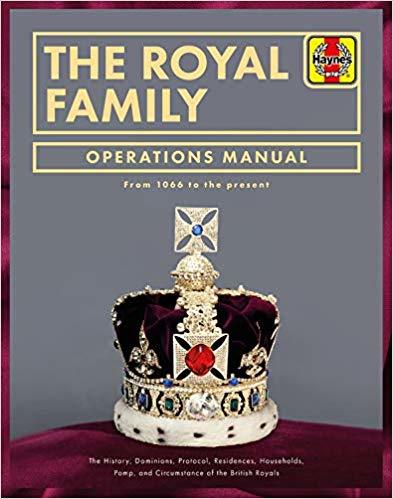
The Royal Family Operations Manual: From 1066 to the present. The history, dominions, protocol, residences, households, pomp and circumstance of the British Royals
Hardcover –24 March 2020 (US) & 6 April 2020 (UK)
This book offers a complete examination of the British Royal Family, looking behind the scenes at the Windsors, their bloodline, family tree and personalities, royal residences, palaces and country retreats, military connections, charity work, and annual engagements.
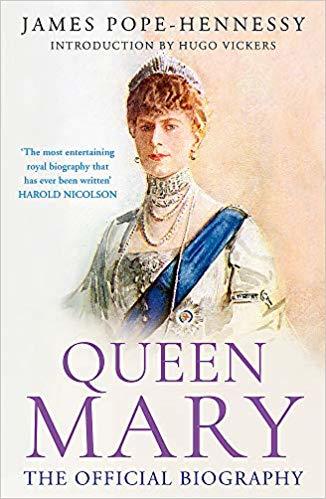
Queen Mary
Paperback – 17 March 2020 (US)
When Queen Mary died in 1953, James Pope-Hennessy was commissioned to write an official biography of her – unusual for a Queen Consort. Queen Mary’s life, contrary to popular belief, was essentially dramatic, and she played a far more important and influential role in the affairs of the British monarchy than her public image might have otherwise suggested. Using material from the Royal Archives, private papers and Queen Mary’s personal diaries and letters, Pope-Hennessy’s biography was a remarkable portrait of a remarkable woman and received rave reviews across the press.
Long out of print, this new edition of Queen Mary will be accompanied by a new foreword from royal biographer and writer Hugo Vickers.
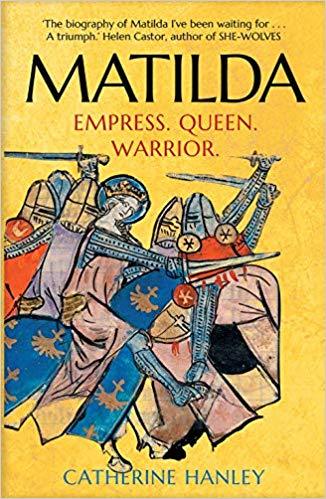
Matilda: Empress, Queen, Warrior
Paperback – 17 March 2020 (US) & 11 February 2020 (UK)
Matilda was a daughter, wife, and mother. But she was also empress, heir to the English crown—the first woman ever to hold the position—and an able military general.
This new biography explores Matilda’s achievements as military and political leader, and sets her life and career in full context. Catherine Hanley provides fresh insight into Matilda’s campaign to claim the title of queen, her approach to allied kingdoms and rival rulers, and her role in the succession crisis. Hanley highlights how Matilda fought for the throne, and argues that although she never sat on it herself her reward was to see her son become king. Extraordinarily, her line has continued through every single monarch of England or Britain from that time to the present day.
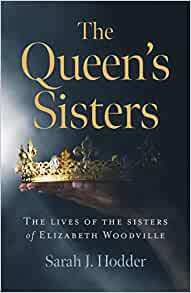
The Queen’s Sisters: The lives of the sisters of Elizabeth Woodville
Paperback – 27 March 2020 (UK) &1 April 2020 (US)
Whether Queen or commoner, the lives of women throughout history is a fascinating study. Elizabeth Woodville, ‘The White Queen’, managed to make the transition from commoner to Queen and became the epitome of medieval heroines the commoner who married a King. When she became the wife of Edward IV her actions changed the life of her entire family. Vilified both by their contemporaries and by many historians since, the Woodville family were centre stage during the reigns of Edward IV and Richard III. Elizabeth Woodville became the ancestress of future Kings and Queens. This book takes a fresh look at the lives of Elizabeth’s sisters. Although information on them is scarce, by looking at the men they married, their families, the places they lived and the events that they lived through we can catch a glimpse of their lives. Each sister has their own story to tell and they may not have achieved the dizzying heights that their sister did, but they are all fascinating women.
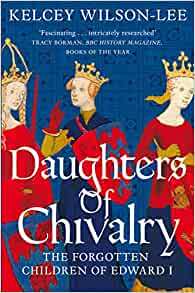
Daughters of Chivalry: The Forgotten Children of Edward I
Paperback – 5 March 2020 (UK)
Virginal, chaste, humble, patiently waiting for rescue by brave knights and handsome princes: this idealized – and largely mythical – notion of the medieval noblewoman still lingers. Yet the reality was very different, as Kelcey Wilson-Lee shows in this vibrant account of the five daughters of the great English king, Edward I.
The lives of these sisters – Eleanora, Joanna, Margaret, Mary and Elizabeth – ran the full gamut of experiences open to royal women in the Middle Ages. Living as they did in a courtly culture founded on romantic longing and brilliant pageantry, they knew that a princess was to be chaste yet a mother to many children, preferably sons, meek yet able to influence a recalcitrant husband or even command a host of men-at-arms. Edward’s daughters were of course expected to cement alliances and secure lands and territory by making great dynastic marriages, or endow religious houses with royal favour. But they also skilfully managed enormous households, navigated choppy diplomatic waters and promoted their family’s cause throughout Europe – and had the courage to defy their royal father. They might never wear the crown in their own right, but they were utterly confident of their crucial role in the spectacle of medieval kingship.
Drawing on a wide range of contemporary sources, Daughters of Chivalry offers a rich portrait of these spirited Plantagenet women. With their libraries of beautifully illustrated psalters and tales of romance, their rich silks and gleaming jewels, we follow these formidable women throughout their lives and see them – at long last – shine from out of the shadows, revealing what it was to be a princess in the Age of Chivalry.
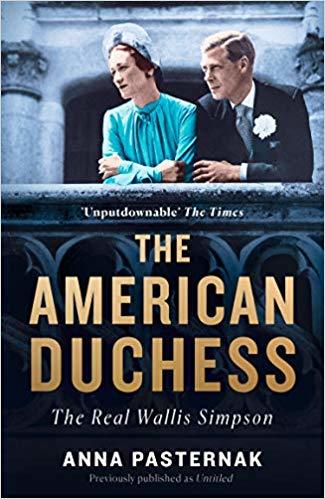
The American Duchess
Paperback – 19 March 2020 (US) & 6 February 2020 (UK)
Life has always been made difficult for those marrying into England’s royal family. In 1936, just months into his reign, King Edward VIII proposed to Wallis Simpson, a divorced American woman. Gossip ran wild, and that cacophony of speculation and distrust both hid the real Wallis, and forced Edward into abdicating so that he might marry the woman he adored.
In this intimate biography Anna Pasternak seeks to understand Wallis – and her relationship with Edward and The Crown. Using testimony from her closest friends, she shows the warm, loyal, intelligent woman who was written off and undermined by the powerful, often manipulative men of the Establishment. This is Wallis Simpson’s story as it has never been told before.
Previously published as Untitled.
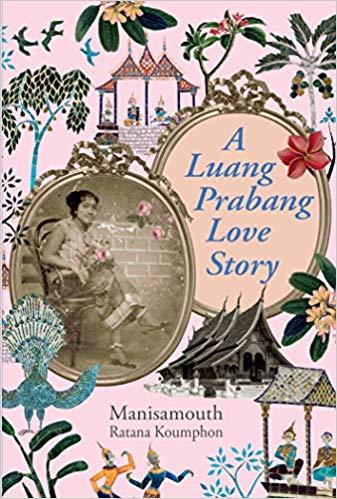
A Luang Prabang Love Story
Paperback – 15 April 2020 (US) & 26 March 2020 (UK)
In 1930s Luang Prabang, the beautiful and demure Kham-Phiou was much admired. On a New Year’s Day, the life of the aristocratic young woman changed when she caught the eye of a sophisticated older man – Prince Souvanna Phouma. The prince fell madly in love with Kham-Phiou and was determined to marry her against all odds. His family wanted a marriage within the dynasty, while her widowed mother feared Palace intrigues. After the wedding, life in the prince’s family home was difficult, but Kham-Phiou began to adapt until the prince decided they should move to Vientiane for the sake of his career. The tale of the tragic love story spans over half a century and is set against the little-known backdrop of old-world Laos where ancient customs and superstitions still held sway.
In this charming and moving personal account incorporating the social history of Laos, Manisamouth, granddaughter of Kham-Phiou, brings her grandmother’s untold story to life, accompanied by evocative black and white photographs, family trees of the Luang Prabang Royals and Kham-Phiou’s lineage, and includes a section on Lao history.
The post Book News March 2020 appeared first on History of Royal Women.
February 20, 2020
The Year of Queen Wilhelmina – Education of a Queen
When the future Queen Wilhelmina was born on 31 August 1880, her elder half-brother Prince Alexander, Prince of Orange was still alive – as was her uncle Prince Frederick of the Netherlands. Under the semi-salic law in the Netherlands, she was thus third in the line of succession. However, Prince Frederick died in 1881, leaving two daughters – Louise and Marie. Prince Alexander was unmarried and sickly, and he too died in 1884. Wilhelmina was now the heiress to the throne and was set to become the first Queen regnant of the Netherlands. But how does one educate a Queen? Especially one that would be expected to rule from a young age – her father was already 63 years old when she was born.
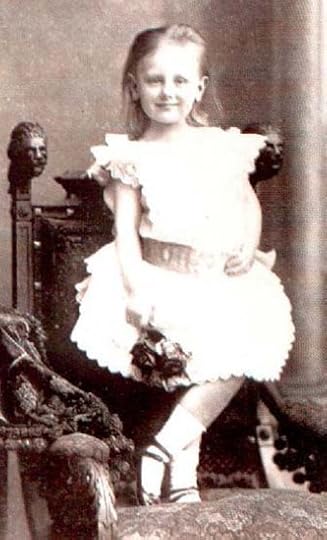 (public domain)
(public domain)From her early youth, Wilhelmina had been raised bilingual – in French and Dutch. On 1 August 1886, an English governess named Miss Elizabeth Saxton Winter was employed, and Wilhelmina would grow very fond of her, and they would keep in touch for the rest of Miss Winter’s life. She set out to “train your character, to make a bold and noble woman out of you, unflinching and strong.”1 Most of all, Wilhelmina would be taught a sense of duty and perseverance. Wilhelmina grew up an only child but sometimes other children were invited to the Palace.
However, when it became clear that her father would not live to see her 18th birthday, her education was sped up. Her education focussed on three languages, French, German and English but also included subjects just for her, like constitutional law and the organisation of the army. Her teacher was Frederik Gediking, who ran a county school in The Hague. He sometimes found it difficult to formally address his special student, and he was not allowed to shake her hand. Miss Winter attended all the lessons with Wilhelmina.
In 1890, her father died at the age of 73 and Wilhelmina became Queen at the age of 10. Her mother Emma would act as her regent until her 18th birthday. From now on, Emma made sure Wilhelmina was seen as the future of the monarchy. Between 1892 and 1896, she and Wilhelmina visited every major city and providence in the Netherlands. Emma also took it upon herself to become her daughter’s teacher in religious matters.
From August 1890, lessons were intensified with a more teachers Dr J.J. Salverda de Grave, F.J.L Krämer, P.J. Blok and C.M. Kan. Emma wanted her to learn history, especially Dutch history, because she believed it was the only way for Wilhelmina to know her people as she was so separated from them by protocol and etiquette. By 1896, her basic education was considered to be completed. The following two years would focus mainly on her constitutional duties.
Embed from Getty Images
When she took up her duties, she was by far the best-educated 18-year-old in the Netherlands. However, it had been a lonely childhood surrounded by people who were much older than her. She later wrote in her memoirs, “Most of the lessons were interesting and there were breaks at the right moment, just when I began to feel tired. My secondary and academic education were combined. I never went beyond secondary level in science and foreign languages (French, German and English). My favourite subjects were Dutch and history.”2
The post The Year of Queen Wilhelmina – Education of a Queen appeared first on History of Royal Women.
February 19, 2020
Will the Countess of Wessex become Duchess of Edinburgh?
Following our Q&A “Is Lady Louise Windsor a Princess?“, we answer another burning question. Will the Countess of Wessex become Duchess of Edinburgh?
The Countess of Wessex, born Sophie Rhys Jones, is the wife of Prince Edward, Earl of Wessex. They were married in 1999, and they have two children together. Unlike her two sisters-in-law, Sophie became a royal Countess and not a royal Duchess. The Earl of Wessex title had been created twice before in the 11th century and was created again for Prince Edward.1 The subsidiary title of Viscount Severn is currently held by their only son James.
At the time of their marriage, it was announced that any children they might have would be styled as the children of an Earl. Any daughters would be a Lady, while the eldest son would be Viscount Severn and any subsequent sons would be styled as The Honourable. At the same time, it was announced that the Earl of Wessex would become Duke of Edinburgh when the title reverts to the Crown.2
The Duke of Edinburgh title has been created twice before. The first creation was in 1726 by King George I who bestowed it on his grandson Frederick, who was also created Prince of Wales in 1729. Frederick predeceased his father and it was his son who became King George III. Upon his death in 1751, the title passed to his son George. When George succeeded as King, the title merged with the Crown.
The second creation took place in 1866 when Queen Victoria bestowed it on her second son Prince Alfred. Alfred’s only son predeceased him and so the title became extinct on Alfred’s death in 1900.
The third creation took place in 1947 by King George VI for Prince Philip and is set to be inherited by his “heirs male lawfully begotten.” This means that when Prince Philip dies, the title will pass to his eldest son – Prince Charles, the Prince of Wales. The title will not revert to the Crown until Prince Charles succeeds his mother as King. The new King is then free to create the title again for his brother – making Sophie Duchess of Edinburgh at last.
The post Will the Countess of Wessex become Duchess of Edinburgh? appeared first on History of Royal Women.
February 18, 2020
The Year of Queen Wilhelmina – The life of her father King William III
The future King William III of the Netherlands was born on 19 February 1817 as the eldest son of the future King William II of the Netherlands and his wife, Anna Pavlovna. He was born in Brussels, which was then still part of the Kingdom of the Netherlands. He was baptised in the Augustine Church in Brussels on 27 March 1817 with the names William Alexander Paul Frederick Louis. Four more siblings would later join the nursery: Prince Alexander (1818 – 1848), Prince Henry (1820 – 1879), Prince Ernest Casimir (1822 – 1822) and Princess Sophie (1824 – 1897). He spent his early years mostly in Brussels as it was the preferred residence of his parents. The education of the boys was entrusted to Thierry Juste baron de Constant Rebecque de Villars – a soldier. It was an intense schedule of studying – six days a week.
William was 13 years old when Belgium became a separate Kingdom, and he saw his future Kingdom being cut in half. In 1836, William, Alexander and their parents visited England where William danced with the future Queen Victoria. By then, he had already begun his studies at the University of Leiden, which he completed in 1837. He had not spent much time in class and instead received tutoring at home.
On 18 June 1839, William married his first wife Sophie of Württemberg, who was also his first cousin. They were married in Stuttgart, and the return journey to the Netherlands also served as their honeymoon. They took their time returning and did not cross the Dutch border at Arnhem until a month later. Sophie and her mother-in-law and aunt Anna did not get along at all, and she had not approved of him marrying her. William and Sophie were not a match made in heaven. She considered him childless and less intelligent than her. He had no moral compass and often had fits of rage.
Nevertheless, Sophie fulfilled her duty and gave birth to her first son on 4 September 1840. It was to be yet another William, though he would be known as Wiwill in the family. Just one month after young William’s birth, King William I abdicated the throne in order to marry his late wife’s lady-in-waiting, Henriette d’Oultremont. William’s father now became King William II of the Netherlands, and William became Prince of Orange as the heir to the throne. On 15 September 1843, a second son named Maurice was born to them. Their marriage remained unhappy, and Sophie even confided in her sister-in-law that she had asked God to let her die in childbirth. William raged against her and also physically attacked her. She did not think William was fit to be King and feared the day, “the King would close his eyes forever. I am begging God on my knees that it may last quite a while yet.”
Unfortunately, the day would come sooner than expected. On 17 March 1849, King William II died in his newly-built palace in Tilburg after a short illness. His son, who was in England at the time, did not learn of his death until a day later. William had already shown himself to be reluctant to become King, especially after the new Constitution of 1848 limited the monarch’s powers even more. As he slowly travelled back to the Netherlands, he continued to doubt if he would accept the crown and had to be persuaded to do so.
On 12 May 1849, his inauguration took place in the New Church in Amsterdam. Even Sophie was impressed and later wrote, “My King behaved himself exceptionally and spoke clearly and with dignity. All and all, we have made a good impression.”
However, tragedy was to come. In May 1850, young Maurice fell ill with meningitis. He died on 4 June 1850 and Sophie never forgave herself for calling on a new doctor. Their shared grief did bring the couple closer together for a time, and Sophie gave birth to a third son named Prince Alexander on 25 August 1851. But their relationship never quite healed and William – by then nicknamed King Gorilla for his large size and many women – found solace elsewhere. Sophie even began a divorce proceeding against her husband, but on her father’s advice, she eventually decided not to proceed. They lived separate lives as much as they could. In the end, their marriage would last until Sophie’s death, which took place on 3 June 1877.
Sophie and William’s eldest son was at his mother’s funeral in Delft, but it was a rare sighting of the Prince of Orange in the Netherlands. He spent most of his time in Paris, where he lived a debauched lifestyle. He had been denied marriage to Mathilde, Countess of Limburg-Stirum. His younger brother Alexander was considered to be “weak” and unlikely to marry and children. This left William’s brother Prince Henry as a possible heir, but he was a widower (his first wife was Amalia of Saxe-Weimar-Eisenach) and childless. A second marriage to Marie of Prussia in 1878 ended with Henry’s death just five months later. Another possible heir was William’s elderly uncle Frederick, who had two daughters (Louise and Marie).
The most likely scenario seemed to be that if William’s son did not have any offspring that the non-ruling descendants of his sister Sophie would take the throne (the Dutch crown could not be united with a foreign crown). William did not want to see a “stranger” on the Dutch throne. Young William’s debauched lifestyle caught up with him, and he died on 11 June 1879.
By then, William had decided to clear up the succession issues himself. He would marry again. His first instinct had been to marry his mistress, but the following public outrage changed his mind. European Princesses were now being lined up for the elderly King. His first choice was Princess Thyra of Denmark, daughter of King Christian IX, who tactfully informed William that his daughter “did not feel capable of fulfilling such a serious and difficult task.” He then approached Princess Marie of Hanover, daughter of King George V of Hanover, and her father refused to consent to the match on his deathbed. He then contacted his sister Sophie, whose daughter Elisabeth was of marriageable age. He personally travelled to Weimar, but Elisabeth felt such a “deep aversion” for her elderly uncle that she could not bring herself to agree to a match.
William then continued his travels to Pyrmont where he was picked up at the train station by George Victor, Prince of Waldeck and Pyrmont. His three daughters also happened to be there: Pauline, Emma and Marie. Marie had married in 1877, but Pauline and Emma were still available. William initially only had eyes for the eldest sister Pauline, but she thought he was too old for her. His attention then shifted to Emma. He stayed for four days before returning home with a spring in his step. Emma had caught his eye.
On 7 January 1879, the 61-year-old William married the 20-year-old Emma at Arolsen. The groom wore the uniform of an admiral, and the bride wore a white dress with a long train, a lace veil, a tiara and an ermine shoulder cover. Emma would have a good influence on William and in 1882 Queen Victoria wrote to her eldest daughter, “The King of the Netherlands is as quiet and unobtrusive as possible; a totally altered man and totally owing to her. She is charming, so amiable, kind, friendly and cheerful.”
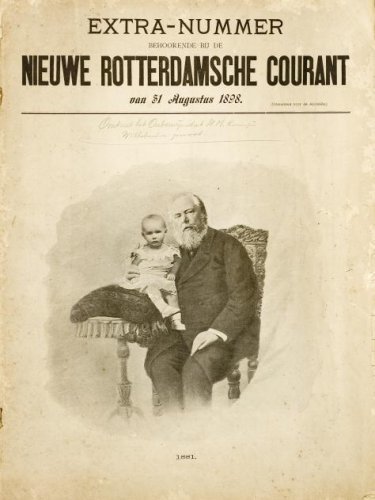 Wilhelmina with her father (public domain)
Wilhelmina with her father (public domain)On 15 March 1880, the couple announced happy news; Emma was pregnant. On 31 August 1880, Emma gave birth to a daughter named Wilhelmina. William was delighted with the birth of a daughter and had even been present when she had been born. Four years after her birth, her half-brother Alexander – whom she had only met once – died. Wilhelmina would have to succeed her father, and it seemed likely that she would still be a minor. Emma would be assigned the regency in case this happened though not everyone thought that a foreign woman was the right person for the job.
Meanwhile, William’s health had been deteriorating steadily. He suffered several meltdowns where he was incapable of ruling, which were most likely strokes. By early 1890, he was confined the Loo Palace. Wilhelmina saw her father for the last time on 25 September 1890. On 20 November 1890, Emma swore the oath as regent for her husband. During the night of the 21st, William suddenly rose from his bed, and when ordered back to his bed, he said, “Who commands here? You or I?” Those were his last words. Over the next two days, William was in and out of consciousness. On 23 November 1890 at 5.45 in the morning, William died at the age of 73 – leaving his ten-year-old daughter Wilhelmina as Queen.1
Wilhelmina later wrote in her memoirs, “Although during the last few months his suffering was such that I could no longer visit him, this period left a deep mark on my life. The atmosphere at Het Loo was dominated by his illness. Everything became strained. When his illness was at its worst Mother spent all her time at his bedside and I hardly saw her. How much much it means to a child when her mother disappears out of her life, and for such a long time! The last night she did not come to bed at all – I had been sleeping in her room for some time – and that night I felt like something terrible was happening upstairs in Father’s room. People tried to hide it from me, but yet I knew what that terrible thing was. When all was over Mother came to my bed and, deeply moved, told me that Father had died.”2
The post The Year of Queen Wilhelmina – The life of her father King William III appeared first on History of Royal Women.



